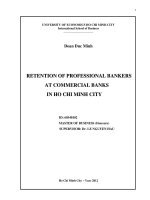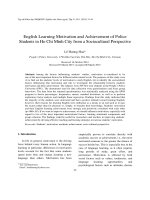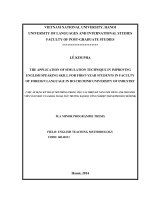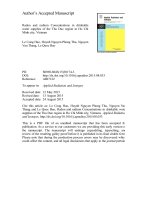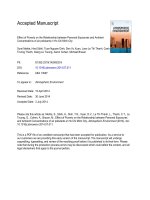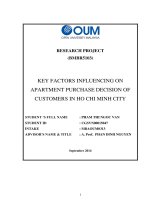COLLEGE STUDENTS’ ATTITUDE TOWARD ONLINE SHOPPING OF APPAREL PRODUCTS IN HO CHI MINH CITY
Bạn đang xem bản rút gọn của tài liệu. Xem và tải ngay bản đầy đủ của tài liệu tại đây (1.09 MB, 82 trang )
VIETNAM NATIONAL UNIVERSITY – HO CHI MINH CITY
INTERNATIONAL UNIVERSITY
SCHOOL OF BUSINESS
COLLEGE STUDENTS’ ATTITUDE TOWARD
ONLINE SHOPPING OF APPAREL
PRODUCTS IN HO CHI MINH CITY
In Partial Fulfillment of the Requirements of the Degree of
BACHELOR OF ARTS in BUSINESS ADMINISTRATION
Student’s name: HUYNH THAI DUONG (BAIU09115)
Advisor: VO TUONG HUAN, LLM
Ho Chi Minh City, Vietnam
2013
COLLEGE
STUDENTS’
ATTITUDE
TOWARD ONLINE SHOPPING OF APPAREL
PRODUCTS IN HO CHI MINH CITY
APPROVED BY: Advisor
________________________
Vo Tuong Huan, LLM
ACKNOWLEDGEMENTS
My thesis is completed with many contributions and support from many people
around. They are the biggest support for me to overcome many struggle and finish this
thesis.
First of all, I want to give my deepest gratitude to my advisor, Mr. Vo Tuong
Huan for his enthusiasm and kindly support me during the thesis process. His advices are
not only useful for me when doing the research but also for my life after graduation.
Thank you.
Secondly, I want to thank staffs in International University for helping getting the
useful material and literature related to my research.
I also want to thank my friends who also doing thesis in this time for give sharing
me the knowledge and advice. Thank you for all the lecturer and students that help me
complete my survey collection, their help for stranger person is a huge contribution for
the complete of this thesis.
Finally, it is my family, my brother, sister who give me metal support during the
hard times. Thank you so much.
Table of Contents
ACKNOWLEDGEMENTS ................................................................................... iii
Table of Contents ................................................................................................... iv
LIST OF TABLE .................................................................................................. vii
LIST OF FIGURE................................................................................................ viii
ABSTRACT ........................................................................................................... ix
CHAPTER I ............................................................................................................ 1
INTRODUCTION .................................................................................................. 1
1.1
Introduction ............................................................................................... 1
1.2
Research purpose....................................................................................... 2
1.3
Research objective.................................................................................... 2
1.4
Research questions: ................................................................................... 3
1.5
Rationale of the research .......................................................................... 3
1.6
Significant of the research ......................................................................... 4
1.7
Limitation .................................................................................................. 4
Chapter II ................................................................................................................ 5
LITERATURE REVIEW ....................................................................................... 5
2.1
Term and definition: .................................................................................. 5
2.2
Online shopping ........................................................................................ 6
2.3
Attitude toward online shopping of apparel products ............................... 7
2.4
College students ‘attitude .......................................................................... 8
2.5
Related research in student’s attitude .................................................... 9
2.6 Hypothesis and research model .................................................................. 11
2.6.1 Hypothesis development ...................................................................... 11
2.6.2 Research model .................................................................................... 16
CHAPTER III ....................................................................................................... 18
METHODOLOGY ............................................................................................... 18
3.1 Research design .......................................................................................... 18
3.2
Literature review ..................................................................................... 18
3.3
Sampling: ............................................................................................. 19
3.4
Pilot study ............................................................................................ 19
3.5
Data collection......................................................................................... 20
3.6
Questionnaire design ............................................................................... 20
3.7
Data analysis .......................................................................................... 21
3.7.1 Descriptive Statistics ......................................................................... 21
3.7.2 Reliability Statistic ............................................................................... 22
3.7.3 Exploratory Factor Analysis ................................................................ 22
3.7.4 Correlation Testing .............................................................................. 23
3.7.5 Regression Analysis ............................................................................. 23
3.8 Measurement scale ...................................................................................... 23
CHAPTER IV ....................................................................................................... 26
DATA ANALYSIS & RESEARCH RESULT..................................................... 26
4.1
Final sample ............................................................................................ 26
4.2
Characteristics of sample ........................................................................ 26
4.2.1 Consumer factors: ............................................................................. 32
4.2.2 Marketing factors .............................................................................. 34
4.2.3 Technology factors ............................................................................ 35
4.2.4
4.3
Students’ attitude .............................................................................. 36
Reliability test ........................................................................................ 38
4.4 Exploratory Factor Analysis ....................................................................... 42
4.4.1 Exploratory factor analysis for independent variables......................... 42
4.4.2 Exploratory Factor Analysis of Dependent Variable ........................... 46
4.4.3 Revision of hypotheses and research model ........................................ 47
4.5 Correlation testing ....................................................................................... 48
4.6 Regression analysis ..................................................................................... 49
4.7 Hypothesis testing result ............................................................................. 51
CHAPTER V ........................................................................................................ 52
CONCLUSION & RECOMMENDATIONS ....................................................... 52
5.1 Conclusion ................................................................................................ 52
5.2
Recommendation ..................................................................................... 54
5.3
Further research: ...................................................................................... 57
Reference .............................................................................................................. 59
APPENDIX A – RESEARCH QUESTIONAIRE ................................................ 62
Questionaire ( Vietnamese version) .................................................................. 62
Questionnaire (English version) ....................................................................... 67
APPENDIX B – COMPONENT MATRIX ......................................................... 71
LIST OF TABLE
Table 1: List of Hypothesis ................................................................................... 17
Table 2: Measurement statement & scale ............................................................. 23
Table 3: the Characteristics of the Samples .......................................................... 26
Table 4: Descriptive statistics of Consumer factors ............................................. 32
Table 5: Descriptive statistics of marketing factor ............................................... 34
Table 6: Descriptive statistics of Technology factors ........................................... 35
Table 7: Descriptive statistics of Students’ Attitude............................................. 36
Table 8: Reliability statistics of Consumer factors ............................................... 38
Table 9: Reliability statistics of marketing factor ................................................. 39
Table 10: Reliability statistics of Technology factors ......................................... 40
Table 11: Reliability statistics of Students’ Attitude ............................................ 41
Table 12: KMO and Bartlett’s Test for Independent Variables ............................ 42
Table 13: Total Variance Explained ..................................................................... 42
Table 14: Component matrix of independent variables ........................................ 43
Table 15: Rotated Component Matrix of Independent variables .......................... 44
Table 16: KMO and Bartlett's Test of Dependent variable................................... 46
Table 17: Component matrix of Dependent variable ............................................ 46
Table 18: Correlation Testing ............................................................................... 48
Table 19: Model Summary ................................................................................... 49
Table 20: ANOVA ................................................................................................ 49
Table 21: Coefficients ........................................................................................... 50
Table 22: Hypothesis testing result ....................................................................... 51
Table 23: Component ............................................................................................ 53
LIST OF FIGURE
Figure 1: Factors affect attitude, intention and four groups of consumers ........... 10
Figure 2: Research model ..................................................................................... 16
Figure 3: Allocation of students’ gender .............................................................. 29
Figure 4: Allocation of students’ rank .................................................................. 29
Figure 5: Allocation of students’ living location .................................................. 29
Figure 6: Allocation of frequency of using internet by students .......................... 30
Figure 7: Allocation of private vehicle using by students .................................... 30
Figure 8: Allocation of monthly income of students ............................................ 31
Figure 9: Allocation of employment status among students................................. 31
Figure 10: Allocation of respondents for using online shopping of apparel
products before.................................................................................................................. 32
Figure 11: Revised research model ....................................................................... 47
ABSTRACT
E-commerce is deal with purchasing products through internet. Internet shopping
make it more convenient to people to give them the ability to buy the product without
actually going to the store or market, not to mention the benefit of available of
information which make it more easier to compare the product and carry out decision.
E-commerce industry in Vietnam began in 1993 but suffer from long time of no
significant development; however there seem to be an upward trend in recent year in this
market. Despite the high number of Internet users, internet shopping still not fully reach
its potential from many drawbacks in payment method and maintain trust between
supplier and buyers.
With the economic development in Vietnam which raises the standard of living,
the demand on clothing has risen significantly in quality and famous brand name. With
the help of technology, customer can easily to purchase their desired product without the
limitation of distance. This encourages the fashion retailer and brands to promote their
online shopping channel to get in touch with their customer more easily.
College students have been long time considered as very potential target segment
for online shopping due to high rate of internet using. However, their different in
characteristics compare to other segment that make the marketing strategies of internet
retailer still not full reach this segment.
To ensure the success of online business, it is important for the retailers to
understand their targets customers. The aim of this study examines factors belong to
online shopping of apparel products and their impact on student’ attitude. A five-level
Likert scales was used to determine students’ attitudes towards online shopping of
apparel products. A self-administered questionnaire based on prior literature was
developed and total 266 post graduate students were selected. The regression analysis
demonstrated the determinant of impact of different factors on student’s attitude, and
from that conclusion and recommendation is given for online retailer of apparel products.
CHAPTER I
INTRODUCTION
The first chapter provides a general introduction for study: the current situation
of online shopping in Vietnam, the college student segment and online shopping of
apparel products. This chapter presents background of this research, the research
purpose and objectives of this research. After that, the limitation will be mentioned.
1.1
Introduction
Online shopping has appeared in Vietnam since 1993. However, it is still very
new form of shopping. Vietnam has ranked on 17st in top countries of Internet users in
2008. According to a survey of McKinsey in January 2012, Vietnamese people spend on
online shopping per year about 3 billion VND, which is much lower than other neighbor
countries like Thailand or Malaysia. The result of this survey also indicates that just 13
percent of Vietnamese Internet users believe that buying products online is trustfully.
Consequently, McKinsey stated in their report that e-commerce in Vietnam is still an
untapped market with high potential for growth. Furthermore, there are few local firms
which have their own official online stores to sell goods directly to customers. Almost
online stores are originated from goods exchange website or forum such as eBay.com and
amazon.com.
College students bring $200 billion a year in buying power to the US market, with
the average college student’s available discretionary spending totaling $287 each month
(Gardyn, 2002). Because of their power in the market place, it is important for retailers
and consumer behavior educators to better understand this population’s attitudes toward
shopping through traditional formats, such as local stores, and new, emerging formats,
such as the internet. Furthermore, 90 percent of college students access the internet daily
1
(Gardyn, 2002). This is huge number of potential customer for e-commerce industry that
no supplier can ignore.
Consumer‘s cognition of product quality was classified into three groups: search
goods, experienced goods, and trust goods. Search goods and trust goods were suitable
for Internet shopping, while experienced goods were suitable for retail stores (Klein,
1998). Search good including CD, books, software while Experience goods including
clothing, shoes and accessories (Klein, 1998). ACNielsen reported that, across the globe,
the most popular items purchased on the internet are books 34 %, followed by videos/
DVD/ games 22 %, airline tickets/ reservation 21% and clothing/ accessories/shoes 20% (
ACNielsen, 2005). In Vietnam, buying an apparel products over Internet still new kind of
products and consumer still hesitate when purchase decision on this these kind of
products. This still undeveloped product segment compare to other kind of popular
product that already popular in Vietnam.
Based on information above, I will choose the topic “College students’ attitude
toward online shopping product in Ho Chi Minh city”.
1.2
Research purpose
College student has been strongly considered as potential market segment for ecommerce industry. However, these consumers don’t get much attention as much as other
kind of customers, mainly because the belief the purchase power of these customer
segment is limited by their tight budget that major of them still live by family support.
Apparel products also considered as the potential product segment for online purchase
that still not reach its full potential. This research aim to analyze factors belong to online
shopping of apparel products, give recommendation for online retailer of apparel
products to improve quality of their service to increase the attitude of students to raise the
purchase intention among this market segment.
1.3
Research objective
Evaluate overall college students ‘s attitude toward online shopping of apparel
products
2
Investigate factors influence college students’ attitude and their relationship
Propose the solution to increase the attitude of college students in the way of become
more positive about online shopping of apparel products
1.4
Research questions:
1. What is overall college students ‘s attitude toward online shopping of apparel
products
2. What factors of online shopping that affect college student’s attitude? To what
extent?
3. Which solution can be offered to raise the attitude among students toward online
shopping of apparel products
1.5
Rationale of the research
Bruin and Lawrence (2000) suggested that college students were often users of
technology in general and likely to buy products online. Today’s web-savvy college
students represent current and future targets for e-commerce companies. Students
represent over sixty billion dollars in buying power today (Bruin and Lawrence, 2000) in
U.S. Study on online shopping often investigate consumer in overall especially consumer
who have significant amount of income e.g. blue collar and office staffs… Students in
Vietnam, on the other hand, suffer from the much lower income compare to other
consumer segment, their difficult in purchase method, or difficult in delivery to remote
area such as campus in Thu Duc… which mean suppliers lost enormous profit from this
potential market segment. Also, it is suggested that their higher than average levels of
education can be expected to generate high levels disposable income, making future
online purchases even more likely. Online merchants, by focusing on this market, can
create brand loyalty and lifetime consumers among a population who will eventually
spend billions more of their dispensable dollars shopping online (Jover and Allen, 1996).
Apparel products that displayed at retail store cost the supplier the huge amount
of place rent fee, cost for salaries of staff and other costs that it won’t applied to online
retail website. The products available also are limited by the distance of delivery, space to
3
display, the available of product and different size on store that can make the consumer
have to go from different stores just to grab of their favorite product. All of this limitation
can be reduced if apparel products can be purchased over internet. (Ann and Paulins,
2004)
This research based on existing study and previous research but apply into
different environment in Vietnam. There are some studies on college students’ attitude
toward online shopping of apparel products but there is no similar in Vietnam, which
leads the need to understand this study on Vietnam field.
1.6
Significant of the research
The finding of this research can be applied by different online suppliers of apparel
products: online vendor, online retailer and fashion brand to create marketing strategies,
advertisement and other strategies on products, price….to reach market segment of
college student in Ho Chi Minh City, and wider is the youth generation of Vietnam.
Furthermore, other related research on online on ecommerce of different type of
products or target different kind of consumer can refer to this study as reference.
1.7
Limitation
The self-reporting distortion may affect the accurate of answer in this survey. The
distortions include: differences between subjects’ interpretation and the real situation,
emotional status, and their social expectation.
Moreover, because of the time and budget constraints, this research carried out
mainly on 3 university in Ho Chi Minh which are International University, Social Science
and Humanity University, Natural Science University can easily gather information,
which represent small sample of population, therefore, this results may be limited and
biased.
This research based on available study , it focus on 3 main factors which
important key issue also influence college attitude may be missing from this research.
4
Chapter II
LITERATURE REVIEW
This chapter focuses on introducing the related definition, concepts and theories
that are used in this research. It means this chapter will introduce the literature review of
online shopping, college student as a market segment, attitude and previous research and
models that used to construct the research model in this study.
2.1
Term and definition:
Attitude: A lasting, general evaluation of people (including oneself), objects,
advertisements, or issues (Solomon, 2003).
Electronic commerce (E-commerce): conducting business transactions over the
Internet or private networks (Donthu & Garcia, 1999). Electronic commerce is any
transaction connected over computer-mediated network channels that transfers ownership
of, or rights to use goods or services, including business-to-business (B2B), business-toconsumer (B2C), and consumer-to-consumer (C2C)
E-trailer: Retailer who develops a shop in cyberspace and does business to
consumer business on the Internet (Frings, 2001)
E-tailing: Electronic retailing or business-to-consumer. Nontraditional retailing
through the Internet, where the customer and the retailer communicated through an
interactive electronic computer system (Frings, 2001)
Internet: a worldwide network of computers that all use the TCP/IP
communications protocol and share a common address space. It is capable of providing
virtually instant access to a vast storehouse of information (Donthu et Garcia, 1999)
Internet Purchase: obtaining a product or service by paying money or using credit
card using the Internet (Lee and Johnson, 2002)
Internet Purchaser: consumer who have had experience buying products on the
Internet (Donthu and Garcia, 1999)
5
Internet purchasing: A behavior of an instance of buying (Donthu and Garcia,
1999)
2.2
Online shopping
Online shopping refers to the process of purchasing products or service over
internet. In the typical online shopping process, when potential consumers recognize a
need for some merchandise or service, they go to Internet and search for need-related
information (Donthu and Garcia, 1999). However, rather than searching actively, at times
potential consumers are attracted by information about products or service associated
with the felt need. They then evaluate alternatives and choose the one that best fits their
criteria for meeting the felt needs. Finally, a transaction is conducted and post-sales
service is provided (Xu and Paulins, 2004).
Shopping online has very different characteristics from shopping in a store. Some
of these characteristics may contribute to consumers’ intention to shop online, while
others may discourage them. In addition to consumers’ psychographics and shopping
online, the fact that the internet is accessible and therefore merchandise is widely
available is important (Donthu and Garcia, 1999).
The acceptance of the Internet as a retail outlet for the consumer has been the
focus of much research (Hoffman and Novak, 1996). Some studies have focused on the
consumers’ attitude towards Internet shopping (Cowles, Little and Kiecker, 2002; Poel
and Leunis, 1999). Poel and Leunis (1999) suggested that the consumers’ adoption of the
Internet for retail purchases focused on three attributes, money back guarantees, price
reductions, and well-known brands. Regan (2002) examined that the factors that would
most strongly increase online shopping would be: an increase in major catalog retailers
taking steps to convert customers into web buyers and overcome the tactile need of online
shoppers to become more comfortable with buying clothing without first touching or
trying on the garment.
Online shopping in Vietnam still consider as the young industry. Up to moment
mostly the online retailer was an online form of real transaction market or forum like
6
eBay.com. Online retailer store of almost any company or fashion brands are still not
popular in this world-most potential retail market. (Le Tran, 2010). Online shopping
show their advantages from lower cost, increase the like of chance to small and medium
enterprise to get in touch with customer, give customer the ability to access to wide range
of products, price, and easy to compare the product ( Le Tran, 2010). However, despite
many benefit above, customers in Vietnam still “hesitate” when trying this kind of
modern purchase.
The problems mostly come from the lack of information about e-shopping that
huge number of Internet users still don’t understand the how to conduct the purchase over
internet. Also it is habit of Vietnamese customer to touch or “try” products because
buying it. To deal with these problems, eBay Viet Nam require the seller to have clear
picture and detail description about the products. It’s also noted that the trust of consumer
toward online shopping is not strong.
Vietnamese law still lack of necessary on these field, thus increase the feeling of
risk from customer. Up to the moment, most e-shopping website tries to make their own
policy and rule to avoid any fraud or cheating by online transaction. They also try to
applied the model from foreign company by applied many promotion and advertising to
customer, conduct campaign to explain the process of online shopping, how to avoid
cheating and fraud to gain trust more from customers. All of these solutions has shown
some consequence on customer, thus according to Le Tran there still need of proper
strategies to fit the context of Vietnam market.
2.3
Attitude toward online shopping of apparel products
Attitude towards a behavior refer to “the degree to which a person has favorable
or unfavorable evaluation of the behavior of question” (Grandom and Mykytyn, 2004).
Attitudes toward online shopping are defined as consumer’s positive or negative feelings
related to accomplishing the purchasing behavior on the internet (Chiu et al., 2005).
According to the study by Armstrong and Kotler, (2000), a person’s shopping
choices are influenced by four major psychological factors: motivation, perception,
7
learning and beliefs and attitudes. That means that, through motivation and perceptions,
attitudes are form and consumers make decision. Attitudes save as the bridge between
consumers’ background characteristics and the consumption that satisfies their needs.
Attitudes describe a person’s relatively constant evaluations, feelings and tendencies
toward an object or idea. Attitudes put people into a frame of mind for liking or disliking
things, for moving toward or away from them (Armstrong and Kotler, 2000).
2.4
College students ‘attitude
College students represented the consumer sample in a study conducted by Then
and Delong (1999). They cited the initial hesitation of shoppers to sue the internet for
clothing and reasoned that this could be due to a lack of visual, tactile, and kinesthetic
experiences online. Thirty-three percent of the college students in their initial survey had
experience looking at an apparel web site. A survey was distributed to those students,
with result indicated that college students who were online shoppers want images of the
apparel products displaced realistically with respect to the ordering online, the college
students in this study indicated security, convenience, and return policy were important
components in their purchasing decisions. Furthermore, respondents indicated that
apparel products sell better online when fit is not a critical factor and they recommended
that online retailers make precuts available that are not easily accessible in other venues.
When comparing males and females, Then and DeLong (1999) noted little difference in
responses.
The familiarity of current college students with the internet coupled with their
emerging market power and the likelihood of developing loyal customers by establishing
initial retailer- customer ties provided requirement to explore this consumer group and
their behavioral intentions for online shopping.
According to result from table 3 “characteristic of sample” in this study, some
characteristics of college students in Ho Chi Minh are partly revealed. It’s likely that
female use this kind of shopping more than male (60.3 % versus 39.7 %). Most of student
used the internet very usually, up to 52.8 % answer “very frequently” and 17.2 % answer
8
“frequently”. Most students have their own vehicle, thus making them less depend on the
delivery service and increase the rate to receive product directly. Almost student have
tight budget, which is 49.2 % answer their income “below 2 million” ad 42.5 % answer
“2 -3 million”. No surprisingly, student in Ho Chi Minh mostly are unemployed ( 61.8
%), compared to other foreign countries while high rate of students have part-time job,
making them more depend more on family support and reduce their income. Finally, the
percent of using online shopping for apparel products before is quite high (72.2 %),
meaning that the major of them already have understanding and experience is this kind of
purchase.
2.5
Related research in student’s attitude
There are findings of the previous studies concern with the studies concern with
the students’ attitude as follows:
Topic: understanding consumer’s online shopping and purchasing intention
Author: Jongeun Kim
Year of study: July, 2004
9
Figure 1: Factors affect attitude, intention and four groups of consumers
Finding: consumer factors pose as the strong influence dimensions among three
factors. Different attitude and profiles of the four groups of online consumers were
developed. Recommend to focus on consumer factors such as convenience and security,
enjoyment… results of the study suggests that successful retailers will respond to the
individual needs of each group if they desire to move them through the stages of noshoppers to buyers.
10
2.6 Hypothesis and research model
2.6.1 Hypothesis development
In order to investigate college students’ attitude, we need to understand
consumers’ characteristics of the segment that influence their attitude towards online
shopping of apparel products. This research based much on the previous research done by
Kim Jongeun (2004) “Understanding consumer’s online shopping and purchasing
behaviors”. Kim Jongeun was the candidate for the degree of Doctor of Philosophy when
conduct this master thesis to graduate as Doctor Degree from Oklahoma University.
Before that, she already got Master of Science Degree from Kon-Kuk University, Seoul,
Korea. Her major field is Human Environmental sciences and her area of specialization
is: design, housing and Merchandising. In this research, the author used the previous
exploratory E-retailing model conduct by Cowles, Kiekies and Little (2004) that group
online shopping issues into 3 main factors and Theory of Reasoned Action by Ajzen and
Fishbein (1975 & 1980) to explain the link from attitude to actual intention. Her research
aimed to analyze the attitude that are influence from issues underlying online shopping
that group into 3 main factors as show below, and attitude will direct affect the buying
intention of consumer that divided into 4 kind of consumer who has different intention.
By comparing the different in term of attitude, intention and demographic profiles,
retailers can give strategies to target non-shoppers to transform into potential buyers.
However this research purpose was to analyze the attitude among the students towards
online shopping of apparel products from the influence of these three factors and give
recommendation to improve service based on this information, intention and 4 groups of
consumers was removed to fit the purpose of this research. The author grouped the online
shopping issues into three areas: consumer, marketing and technology issues that most
often are noted as influencing online shopping attitudes. The factors belong to 3 factors
were modified slightly to investigate further down to apparel products and college
student. Factors from research “college students’ attitude towards online shopping of
11
apparel products: exploring the rural versus urban area” conducted by Xu and Paulins
was also used as reference to the modify factors of this research to fit the specific data.
2.6.1.1 Consumer factors
The consumer factor was suggest as important to online shopping, and items
include were privacy, security, time saving, , convenience, enjoyment, (Udo, 2001).
Fashion brand was added as another factor belongs to apparel products and have related
to consumer (Xu and Paulins, 2004). It also noted that most college student don’t pay
much attention on their own privacy information and more willing to give this
information away ( Then and Delong, 1999), making privacy unassay in this research.
Security: security is defined as that which secures or makes safe, protection,
guard, defense (Komiak, & Benbasat 2004). Online retailing has greater perceived
security risks by consumers than does traditional brick and mortar retailing (Houston,
1998).Research suggested that most consumers fear the risk of misused credit card
information.
To increase online shopping, merchants need to take the proactive steps to
minimize the consumers’ feeling of risk. One method of doing that includes building of
consumer trust in the online store (Komiak and Benbasat, 2004). In the area of financial
security, this meant proving the merchant’s ability to safeguard personal data. Gabarino
and Johnson (1999) have proposed a satisfaction-trust-commitment-repurchase intention
model and found that consumers; satisfaction would built trust which led him or her to
repeat the purchases.
The security of payment is evaluate high by student, but it can’t denied the fact
that rate of using online payment method like ATM and credit card still under hesitate
from students in Vietnam due to its unfamiliar and risk of losing financial account ( Le
Tran, 2010). Company often deal with them by offer COD ( cash- on –delivery) as a
payment for customer to avoid using the online payment and bank account transfer (Le
Tran, 2010), but both method still have disadvantages compare to online payment for its
convenience and time saving and avoid problem by distance. Delivery often don’t reach
12
the place where gather high number of students like Thu Duc district or district 9 and
district 12, due to their long distance from the store.
Time: Becker (1965) noted the efficient use of time was critical use for the
modern time-scarce consumer. Internet shopping can be viewed as a time saver for the
shopper and the buyer (Then and Delong, 1999). As such, time positively influence
Internet shopping as it can eliminate trips to the store and the long lines and delays when
at the store (Donthu and Garcia, 1999).
Time is also crucial problems that student choosing to use online shopping. Their
time often is occupied from the schedule of class and activities that don’t have time to go
to store on official time. Also note that many students in Ho Chi Minh City lived in
suburban area, thus making its high time taking form long trip just to visit the store.
Convenience: One such attitude that influenced the non-store shoppers has been
that convenience (Shim and Mhoney, 1991). The non-consumer’s primary motivation
was to save time, money, and hassles associated with in-store shopping. Non-store
shoppers sought to solve these issues by utilizing catalogs, cable television shopping,
Internet, and other shopping formats. The same attitude of convenience cared over to the
consumer’s Internet shopping’s behavior. Convenience has been noted as positively
influencing online purchasing behavior as it eliminated the necessity of having to travel
to one or more stores.
Enjoyment: Enjoyment in shopping can be two-fold: Enjoyment from the product
purchased as well as the process of shopping itself. Online shopping likes in-store
shopping, provided both types of enjoyment can positively or negatively influence online
shopping (Taylor & Cosenza, 2009). Enjoyment is also necessary factor that attract
young generation to using the product or service ((Then and Delong, 1999).
Fashion brand: by having well-known fashion brands another element that attract
customer to pay visit and make actual transaction on particular online shopping channel.
13
Famous fashion brand also are more likely to attract customer to their distribution (Xu
and Paulins, 2004).
2.6.1.2 Marketing factors:
Price; price of online shopping are reduced by avoid cost of normal retailer. Also
the price come along with products make consumer easier to make consider when
purchase (Taylor and Cosenza, 1999).
College students who often have tight budget, depend much more on online
shopping to search for products with attractive price (Then and Delong, 2009). If the
price of online shopping is really competitive, then the like hood of chance to using this
service will increase among students.
Products variety: when shopping, consumers want a broad range of quality, price,
and variety in products. The online market allows for such diversity thus potential
increasing online sales (Taylor and Cosenza, 1999)
Product promotion: product promotions attempt to influence the consumers’
purchasing behavior. Like other retail methods, online channels have various promotional
tools such as corporate logos, banners, pop-up messages, e-mail messages, and text-based
hyperlinks to web sites. These types of promotions have positively affected Internet
buying (Ducoffe, 1996).
Delivery methods: online purchasing typical involves the use of a delivery service
because of the physical separation between the buyer and the seller. For the consumer,
this separation brings a concern about the time lag between when a product is ordered
and when it is received as well as the potential added cost of delivery. These concerns
had a negative effect on online shopping (Eastlick & Feinberg, 1994).
For college students, delivery takes very important function because most of them
don’t have spare to go take product from the store. Cash-on-delivery payment makes
delivery become more important in Vietnam situation.
Return policy: the separation of buyer and seller noted above also plays a role in
the consumer’s level of comfort in regard to product returns. Today, businesses often
14
respond to a customer’s request to return a product by repair, substitute, or refund the
customer’s money. In the case of online shopping, where the majority of products have
been delivered through some third-part means, the customer is now faced with utilizing a
similar service in the return process, an additional inconvenience and potential expense.
These issues negatively affected online shopping behavior. It is important to note that
since online shopping does not allow a consumer to examine the product before
purchasing, online shopping has experienced higher return rates when compared to
traditional retailing ,especially for type of experienced good such as apparel products…
By the year 2005, it is estimated that 90 million items bought online will be returned
(Forrester Research, 2002).
Customer service: Walsh and Godfrey (2000) suggested that e-tailors might have
an advantage over brick and mortar counterpart in the area of customer service with their
use of personalized web sites, product customization, and ad value-added work.
Similarly, Scott (2000) assert that individuals who sought customer service were likely to
purchase at the online store.
On the other hand, the product delivery and product return issues may negate the
perception of personal service (Schneider and Bowen, 1999). Modern consumers put a
premium on personal service (Scott, 2000). The lack of face to face service is certainly a
limitation for Internet shopping and may negatively affect it (Schneider & Bowen, 1999)
2.6.1.3 Technology factors
To a degree, online buying will depend on the efficiency and availability of the
technology (Bell and Gemmell, 1996). Two main technology factors were suggested as
important to online shopping: information and representatives of pictures and colors
(Seckler, 1998). “The availability of personal computers and Internet access” , along with
“ Download time” was also mentioned in Kim Jougeun‘s study model, but with the
advance of internet in Vietnam and the available of Internet access for college students in
Ho Chi Minh City, this was rejected.
15
Information: Information about the product is the first criteria that consumer
looks for when go searching the internet. Sufficient information mean that consumer
understands clearly about the product and increase the chance of making actual purchase
decision, especially for experienced good like apparel products. Not enough information
will create confuse in customer, thus likely to make customer pay less trust about product
and effect their online shopping behavior (Seckler, 1998).
Representativeness of Pictures and Colors: consumer behavior is also impacted
by the accuracy of the products displayed. Varying technology may make it difficult to
represent the true colors or dimensions of a product. This distortion made consumers
uneasy about making an online purchase therefore, negatively affecting online shopping
behavior.(Eroglu, Machleit & Davis, 2003).
2.6.2 Research model
Consumer factors
H1
Marketing factors
Security
model
Technology factors
Time saving
Price
Convenience
Product variety
Enjoyment
Promotion
Fashion brand
Delivery
Return policy
Customer service
H1
College
H
attitude
toward online shopping of
apparel products
Figure 2: Research model
16
abundant
H2
Information
H3
Representativeness


